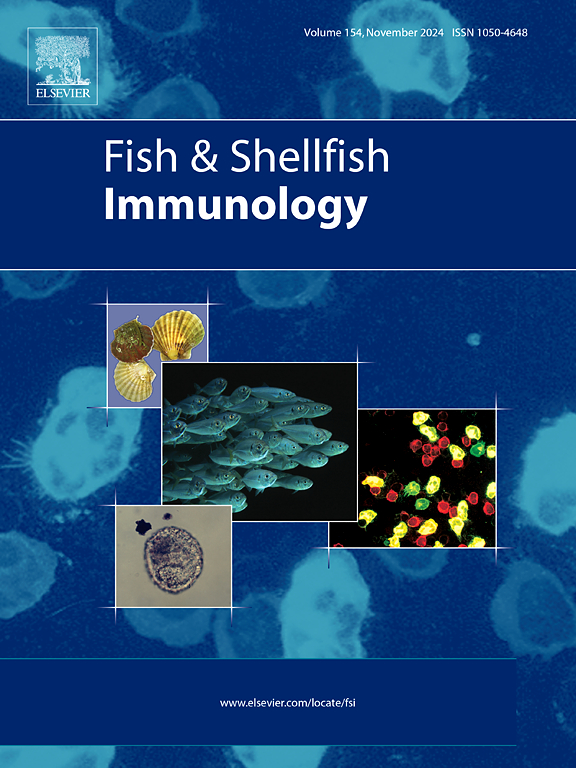Six novel subtypes of haemocyte defined in the Pacific oyster Crassostrea gigas
IF 3.9
2区 农林科学
Q1 FISHERIES
引用次数: 0
Abstract
The primitive innate immune cells (termed haemocytes) initially evolved in molluscs, which are analogous to vertebrate leukocytes, displaying significant morphological and functional heterogeneity. Elucidating the diversity morphology and functions of haemocytes is crucial to understanding the ancient immune system. In the present study, six novel haemocyte subtypes, including pro-haemocytes, larger agranulocytes, secretory haemocytes, amoeba phagocytes, macrophages and dendritic (DC)-like haemocytes were identified by their specific morphological and functional characteristics in oyster circulating haemolymph. Pro-haemocytes, characterized by their minuscule size and high proliferation, were identified as haemocyte precursors to be essential for ensuring the appropriate number and ratio of haemocytes. Amoeba phagocytes were designated for their stronger migration activity, continuous morphological changes, and capability to engulf cell debris or apoptotic cells. The phagocytic index of amoeba phagocytes, macrophages and granulocytes was assessed to evaluate their phagocytic capabilities, which were seven, two and ten, respectively, indicating that granulocytes exhibited the strongest phagocytic ability. DC-like haemocytes were identified based on their specific dendritic pseudopodia and potential role in antigen processing. The results enhanced our cognizing of the complexity of primitive immune cells in molluscs and offered insights into the evolution of the innate immune system.
在太平洋牡蛎长牡蛎中定义的六种新的血细胞亚型。
原始先天免疫细胞(称为血细胞)最初在软体动物中进化而来,与脊椎动物白细胞类似,表现出明显的形态和功能异质性。阐明血细胞的多样性形态和功能对了解古代免疫系统至关重要。在本研究中,通过牡蛎循环血淋巴中特定的形态和功能特征,鉴定了六种新的血细胞亚型,包括前血细胞、大粒细胞、分泌型血细胞、阿米巴吞噬细胞、巨噬细胞和树突状(DC)样血细胞。前血细胞,其特点是其微小的大小和高增殖,被确定为血细胞前体,是必不可少的,以确保适当的数量和比例的血细胞。变形虫血细胞具有较强的迁移活性、持续的形态变化和吞噬细胞碎片或凋亡细胞的能力。通过对阿米巴原虫吞噬细胞、巨噬细胞和粒细胞的吞噬指数进行评价,分别为7、2和10,表明粒细胞的吞噬能力最强。dc样血细胞的鉴定基于其特异性树突假足及其在抗原加工中的潜在作用。这些结果增强了我们对软体动物原始免疫细胞复杂性的认识,并为先天免疫系统的进化提供了新的见解。
本文章由计算机程序翻译,如有差异,请以英文原文为准。
求助全文
约1分钟内获得全文
求助全文
来源期刊

Fish & shellfish immunology
农林科学-海洋与淡水生物学
CiteScore
7.50
自引率
19.10%
发文量
750
审稿时长
68 days
期刊介绍:
Fish and Shellfish Immunology rapidly publishes high-quality, peer-refereed contributions in the expanding fields of fish and shellfish immunology. It presents studies on the basic mechanisms of both the specific and non-specific defense systems, the cells, tissues, and humoral factors involved, their dependence on environmental and intrinsic factors, response to pathogens, response to vaccination, and applied studies on the development of specific vaccines for use in the aquaculture industry.
 求助内容:
求助内容: 应助结果提醒方式:
应助结果提醒方式:


